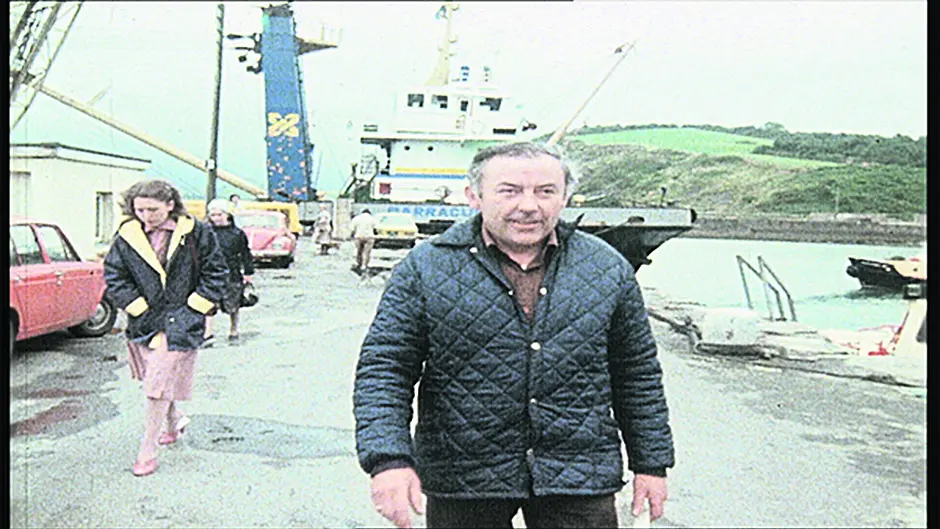We are not used, in this country, to having Tribunals which lay the blame on named persons in stark terms. But Mr Justice Declan Costello didn't hold back when, on July 25th 1980, his report into the Whiddy Disaster was published.
And an RTÉ Frontline programme broadcast that night sent shockwaves through Bantry when its summary of the report – presented by the excellent Brian Farrell – laid out clearly, in graphic form, how the time claimed by many of the Gulf employees, as having been the first sign that anything was wrong, was up to 20 minutes after eyewitnesses all along Bantry Bay had seen flames at the jetty.
‘A gap that meant the difference between life and death for 50 souls,’ said Farrell.
The report itself was shockingly black and white in its conclusions.
‘Evidence established that the despatcher had given a fallacious account of what he knew of the events of the disaster, and that four other Gulf employees failed to tell the truth to the Tribunal,’ wrote Tribunal chairman Mr Justice Declan Costello, a former Attorney General.
He certainly pulled no punches – on any level. An entire chapter of the massive report was entitled ‘Suppression of the Truth’ wherein he named five Gulf employees whose evidence was in direct contravention of several independent eye-witnesses, regarding the timing of the event.
The despatcher in the control room, John Connolly, along with four others, Bruce Tessyman, James Kearns, Donal Hurley and Patrick O’Donnell, were all singled out for special mention.
Another chapter was entitled ‘Gulf’s allegations against the gardaí’ in which Justice Costello stated how Gulf claimed gardaí had lied under oath. ‘The Tribunal must deprecate the use by Gulf of the Tribunal’s public hearings to advance baseless and unwarranted criticisms against officials,’ it stated.
The chairman went so far as to say: ‘It should be recorded that the Tribunal considers that the investigation by the gardaí was carried out with commendable efficiency and with complete propriety: and that, notwithstanding the difficulties placed in their way by certain Gulf employees, the Garda authorities succeeded in obtaining a great deal of evidence which was vital for the purpose of ascertaining the truth of the disaster and without which the Tribunal’s task would have been much more difficult.’
The entire Tribunal sitting, which heard from 184 witnesses, on 65 days and at two locations (Bantry and Dublin) was riddled with dramatic and often bizarre moments.
Dr Kenneth Black, an explosives expert, resigned from the Tribunal as a technical expert, describing some of the evidence as ‘a most extraordinary state of affairs’.
He said there was such a serious discrepancy over the times of the events as given by the Gulf personnel and the consensus of 15 to 20 independent witnesses that he simply could not fathom it. After telling one Gulf employee to stop ‘fencing’ his answers, Justice Costello imposed restrictions on his questioning.
In response, Mr Black – who was also involved as an expert in the high profile 1980 Dingo baby case in Australia – dramatically resigned and penned a letter to the Tribunal in explanation of his decision. ‘I only know of one way of inquiring into serious accidents,’ he wrote, ‘and that is to pursue the truth as fairly and as honestly as I can without fear or favour to anyone. I cannot do this now.’
The report itself reads like a thriller – the eyewitness evidence is riveting.
On that frosty but bright winter’s night, there were plenty of people about because being a Sunday night, there was a dance in the Westlodge hotel. And, given it was just days after Christmas, there were also a lot of people out visiting.
The report also noted that a lot of dogs were disturbed by the noises coming from the jetty – which resembled thunder – rousing their owners.
Despatcher John Connolly claimed he was in the control room on Whiddy, overlooking the jetty when the fire first occurred.
‘If his evidence is accepted, then Gulf clearly had no responsibility for what happened and none of its employees could have done anything to minimise the effects of the disaster or save any lives,’ wrote Justice Costello. ‘In the log he kept that evening he entered the commencement of the casualty as having occurred at 00.55 hours.’
However, the judge added: ‘The evidence of the despatcher and four of his colleagues is directly and irreconcilably contradicted by a large number of persons who saw or heard the disaster at a time much earlier than that deposed to by the despatcher and his colleagues.
‘If the evidence of these eyewitnesses is correct, then a fire was raging on the ship and the jetty at a time when the despatcher says that he was watching the scene continuously, and nothing untoward was happening, and at a time when, according to the crew of the Donemark (personnel launch), a visitor was being left at Dolphin 22 (on the jetty).
‘The Tribunal was fortunate in having available to it a considerable number of witnesses whose memory was accurate, whose powers of observation were well developed and whose testimony could be cross-checked with other reliable evidence.
‘With the aid of this evidence it has been possible to ascertain when the disaster began and obtain an accurate description of its progress. The Tribunal has no hesitation in accepting this evidence and rejecting that of Gulf’s despatcher and that of his fellow-employees.’
The report said there were a number of persons on duty on, or near, the island on the night of January 7th/8th. One of them was John Downey, a pumpman on duty.
‘His evidence, which is completely acceptable, quite definitely establishes that the fire must have commenced sometime after 00.29 hours on the morning of the 8th of January,’ said the report.
Another eyewitness on the night was Frank O’Mahony, who lived at Dromkeal, a short distance to the north-west of Ballylickey. Mr O’Mahonv said he was dozing when he was awakened by his wife. He got out of bed immediately and looked at the clock which was beside him. It was a little after 00:40— the clock had not reached 00:45.
He saw the fire which he thought was to the right of the offshore jetty. The night was a very clear one and he had a perfect view of the terminal.
There was little or no wind and he went into the garden and watched the flame and smoke from there. Then he heard a loud explosion and saw a ‘vast white sheet of flame’ which soared into the sky and at that stage the floor under his feet shook and the window shook.
The flames then spread to the north. After the explosion, there were continuous creaking and tearing sounds which he had not heard before the explosion took place.
Another witness to give evidence was Garda Pat Joy who spotted the flames that night when he was out investigating another incident. He went to the garda station and asked Garda Flynn whether he had contacted Gulf Control and was told that Garda Flynn had tried but had failed.
Garda Flynn’s second attempt to get through to Gulf Control was successful. Garda Flynn asked the person to whom he was talking whether they were in trouble. The voice answered ‘Yes’.
Garda Flynn asked did they need assistance and was told that they ‘needed all the assistance they could get’.
Former Garda Supt JP Twomey, who was a sergeant in Bantry at the time, recalled getting out of his sick bed to come on duty that night, after hearing about the explosion.
‘The phone was hopping the whole time,’ he told The Southern Star recently. ‘In the early hours of the morning, it was like a market day in Bantry, there was so much activity. We put our major accident plan into force, and gardaí and emergency services were drafted in from all over the region. But, of course, there were no survivors.’
He recalled Royal Navy helicopters coming in from Wales to help in the search for bodies, because the Irish Defence Forces had no night-time equipment then.
And he recalled the tragic story of Teresa Shanahan who was driving to Bantry at about 4am to have her baby when she was stopped by a garda near Bantry House.
When he heard she was about to give birth, he was afraid she might hear about the unfolding tragedy at Whiddy, and the fact her husband Liam Shanahan was missing, so he got in the car with her and brought her to the hospital.
She didn’t find out the fate of her husband – who was one of the seven Irish men lost that night – until some days later. She named her son Liam Jnr.
Now a teacher in Skibbereen, Liam Jnr will celebrate his 40th birthday this year – on a poignant anniversary for his family. ‘It took years for Bantry to get over that night,’ said the now-retired Supt Twomey, adding that some time later, he found light pieces of metal in his garden, which lies about a mile-and-a-half on the Dunmanway side of Bantry.
Similar pieces of debris were reported in gardens on the opposite side of the town – on the Glengarriff road.
And the explosion was heard clearly as far away as Skibberen and Dunmanway with windows broken all over the Bantry and Skibbereen areas by the force of the blast.
The was huge emphasis on the night on keeping the large oil tanks on the island cooled, and firemen spoke of their uniforms melting in the 1,000-degree Celsius heat.
Locals believed that if those tanks had blown that night, all of Bantry would have gone up in flames.








